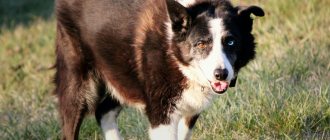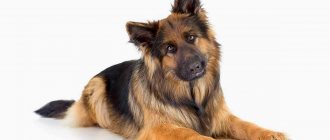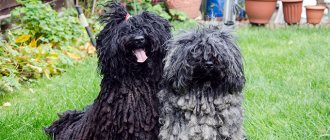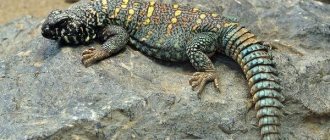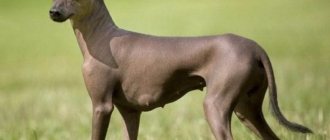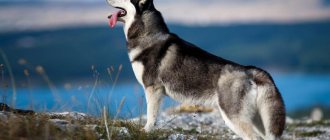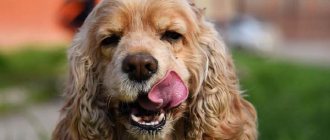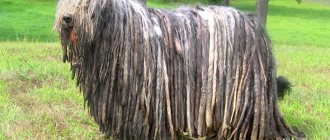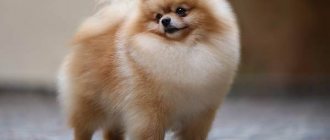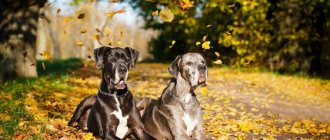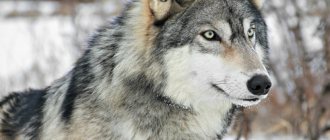Terriers are considered one of the largest groups in terms of the number of representatives among breeds. There are more than 30 varieties, which are divided into 4 main subgroups. Among them are hunting, decorative and service dogs. Different sizes of dogs allow you to choose a pet to suit your goals. Dog handlers distinguish terriers by size, coat length, and main purpose. When choosing a dog, you need to focus on the main characteristics of the breed and know the behavioral characteristics of a real hunter.
Australian Terrier
Compact dog, height 25.5 cm, no more. Build common among short terriers: somewhat elongated body, short legs. The coat is straight, the outer coat is hard, about 6 cm, the undercoat is moderately thick and short. Various colors: gray, blue, sand, red. He has a surprisingly smart, meaningful look.
The breed is the result of artificial selection. It is assumed that the breed is a hybrid of animals that arrived with English settlers. The date of birth of the breed is attributed to the 19th century. Initially she hunted rodents, drove rabbits and gophers out of their holes. Later she showed herself in the security and watchdog field.
Australian Silky Terrier
Silky-coated terriers are very moderately sized animals, weighing 4-4.5 kg. Maximum height is 25 cm. The body type is typical for small terriers. The length of the topcoat is approximately equal to half the height of the dog. The wool is thin and silky to the touch. Thanks to the quality of the wool, it has taken a confident position in the group of decorative dogs.
The breed is a hybrid of various terriers, bred artificially, officially recognized in 1933. The dog is classified as an ornamental dog, but retains its skills in hunting rodents and small burrowing animals. It can not only blissfully rest in the hands of its owner, but also easily catch a mouse.
Miniature Schnauzer
The Miniature Schnauzer is a bred version of the larger Standard Schnauzer. Both schnauzer breeds, as well as their cousin, the Giant Schnauzer, originated in Germany, where they were essential working farm dogs and rat catchers.
Miniature Schnauzers are energetic, playful and require moderate daily activity. The wiry coat that forms the breed's beard, mustache and eyebrow requires professional grooming every few months.
American Hairless Terrier
An extravagant breed with a wide range in height, short hairless terriers do not exceed 25 cm, tall ones reach 46 cm. In addition, despite the name, the hairless terrier is not prevented from acquiring short, clinging hair. Hairless individuals have very smooth, warm skin.
Animals with hairless skin are considered the most hypoallergenic. But they have other problems caused by the lack of natural protection of the body. Hairless dogs must be protected from sunlight and cold water. Hunting work with such a body is also difficult.
How to choose the best puppy
If you decide to get a terrier, then first you need to pay attention to the size. A wide range of hunting dogs allows you to choose from a small dog or a large dog. The ideal dog for an apartment would be one that does not take up much space. For a country house, choose a corpulent pet.
To avoid problems with health and education, you need to know a few points:
- buy only from trusted breeders who have been breeding the breed for a long time;
- when choosing a puppy from a litter, pay attention to active behavior, absence of visible signs of disease (tearing eyes, discharge, cleanliness of coat);
- by nature, terriers are overly dynamic, showing interest in everything that moves, so monitor their behavior in the enclosure or cage;
- ask the puppy owners for documents, including veterinary vaccination certificates and parent pedigrees;
- Find out the peculiarities of living in an apartment, house, approaches to feeding, possible problems.
An experienced dog handler will be happy to tell you about the advantages of the breed and its characteristics. If you notice that the breeder is haggling, lowering the price, then this is a reason to think about it. There are not always honest sellers who sell healthy puppies.
To confirm the health of the dog, you need to make sure that you have a veterinary passport and registration in a canine monobreed association. It is important to avoid the results of inbreeding, which leads to the manifestation of genetic diseases (pelvic dysplasia, problems with vision and the digestive tract, infertility).
American Staffordshire Terrier
The long and difficult to pronounce name of the breed is often shortened to “Amstaff”. There are other types of Staffordshire Terrier . Namely: the English Staffordshire Bull Terrier, its short name is “Staffbull”. Medium sized dogs. They grow to almost 50 cm. Their weight approaches 30 kg.
The appearance is more like a bulldog. Short hair does not hide the muscularity of the body. The chest is wide, so much so that the forelimbs are widely spaced. The stomach is taut. An Amstaff in a standing position is a dog ready for battle.
The ancestors of the American Staffordshire Terrier participated in dog fights. Together with the settlers they ended up in the North American States. Here they were subjected to active selection. For a long time they were indistinguishable from pit bull terriers. In 1936, the existence of differences was recognized and personal standards were drawn up for both breeds.
Breed traits
Breed traits (on a 5-point scale)
| Boston Terrier | |||
| Activity | in the house | 3.9 | |
| on the street | 4.1 | ||
| Obedience | training | 3.5 | |
| strangers | 3.6 | ||
| Domination | in family | 1.9 | |
| over dogs | 2.6 | ||
| Defending your territory | from people | 2 | |
| from dogs | 2.4 | ||
| Sociability | in family | 5 | |
| with strangers | 4.3 | ||
| with dogs | 3.1 | ||
| Concentration | in family | 1.6 | |
| in front of strangers | 1.6 | ||
| with dogs | 1.9 | ||
| Aggressiveness | in family | 1.4 | |
| to strangers | 1.7 | ||
| to the dogs | 2.5 | ||
| to cats | 2.5 | ||
| Family behavior | calmness | 4.3 | |
| demand for affection | 4.9 | ||
| excitability | 4.2 | ||
| playfulness | 4.6 | ||
| excessive barking | 1.9 | ||
| behavioral breakdowns | 2.1 | ||
| Tolerance for children | up to 4 years | 3.9 | |
| over 4 years old | 4.2 | ||
| Institutional use | watchman | 3.3 | |
| bodyguard | 1.6 | ||
This breed is often compared to the following dog breeds: French Bulldog, Pug, German Boxer, Beagle, Jack Russell Terrier.
The photo shows what Boston Terriers look like:
Bedlington Terrier
The dog has the appearance of a sheep. This likeness of a lamb weighs 8-10 kg and grows up to 40 cm. Two centuries ago it was considered a good hunting dog. But the aristocracy saw exceptional decorative features in the dog and Bedlingtons began to turn into companions.
Later, already in the 20th century, connoisseurs of these dogs came to their senses and began to develop the working, hunting branch of the breed. Today, these terriers are poorly distributed. The price of purebred Bedlington Terriers is very high. By owning these dogs, people demonstrate a high level of well-being and belonging to the aristocracy.
Border Terrier
The most tireless species of small terriers engaged in real hunting. The usual weight for these dogs is 5-6 kg. They do not grow above 28 cm. The body proportions are correct. The coat is short, with high-quality undercoat, protecting animals from bad weather and injury.
The breed originated in the north of England in areas bordering Scotland. Hence the word “border” - border - in the name of the breed. Throughout their history, Border Terriers hunted foxes and martens. But the 20th century changed everything. Due to their small size and friendly nature, terriers have become companions.
Scottish
The Scottish Terrier, or Scotch Terrier , is a breed of dog that was bred in Scotland for hunting purposes. The first mentions of it date back to the 16th century.
Scottish Terriers grow on average 25-28 cm and weigh 8.5-10.5 kg. They give the impression of being strong and strong dogs. Their body is muscular. The head is proportional to the body, elongated, located on a powerful neck. The eyes are small, oval in shape, dark in color. The ears are small, erect, triangular in shape. The paws are large.
The wool is very hard, its structure resembles a fishing line. It forms eyebrows, a mustache and a beard on the muzzle, and “pants” and a “skirt” on the body. The standard specifies three colors: black, wheaten, brindle.
The character of Scottish terriers can be described in a few words: agile, decisive, intelligent, hardy, persistent. Does not get along well with children and other animals. Needs early socialization, strict training and frequent walks.
On average, Scottish Terriers live 12-14 years. For puppies they ask from 100 to 1000 dollars.
Boston Terrier
A hybrid of two English breeds, bulldog and terrier. Selection work took place in the United States in the city of Boston, approximately 150 years ago. The dog is not large, weighing no more than 11-12 kg. Bulldog features can be discerned in appearance. The appearance is diversified by large ears and a somewhat sad (due to heavy eyelids) look.
There is only one utilitarian purpose - a companion dog. Residents of Massachusetts liked this half-terrier, half-bulldog so much that they made him the symbol of their state. Breeders appreciated the popularity of the dog and developed three varieties:
- minimum (up to 7 kg);
- medium (up to 9 kg);
- normal, standard size (up to 11.4 kg).
What to consider when choosing a dog
Bulldogs: types of dog breeds, what are they?
There is a fairly large group presented above, so it may be difficult to choose. It is recommended to consider the following:
- almost all representatives are active;
- difficulties may arise with upbringing;
- Puppies should only be taken from the kennel after vaccinations;
- Most of the group's representatives live for about 10 years.
Important! When choosing, the first thing to consider is the purpose for which the pet is being acquired.
The terrier group is particularly popular. Many of its representatives are small in size, making it easier to maintain in an apartment. In any case, before purchasing, you should weigh all the pros and cons of the variety, so as not to regret it later.
Bull Terrier
In the 19th century, as a result of mixing an English bulldog, a Dalmatian and an English terrier, a hybrid was obtained - the bull terrier. The result was an active, strong, compact (up to 30 kg) dog. The appearance of the terrier retains slight hints of kinship with the bulldog. A dog of this breed was shown to the public in 1862.
The breed was bred in Birmingham, and James Hinks supervised the breeding work. It is unknown what goals he set for himself. But the breed turned out to have a very unusual, unique appearance. Particularly impressive is the head with smooth contours and the cold gaze of small, narrow eyes.
Head
A distinctive feature of the French Terrier is its square head with bat ears. The expression of the muzzle is wary, curious and interested. The eyes are dark, brown or almost black, widely spaced, deep-set (as far away from the ears as possible), round, medium in size, neither sunken nor protruding. Light brown eyes are acceptable but not desirable. Blue and green shades are disqualifying.
The top of the skull is flat between the ears, the forehead is slightly rounded. The muzzle is wide, the cheek muscles are well developed. Nose is black. The cheeks are thick and wide, hanging over the sides of the lower jaw.
Welsh Terrier
Animals of the Welsh or Welsh terrier breed are very similar to Airedale terriers, but they are not related to them. Dogs of modest size: height no more than 39 cm, weight up to 9.5 kg. Welsh Terriers are well built, their temperament is visible in the contours of their body, and their readiness to move is visible in their stance.
Welsh Terriers are considered the oldest in the UK. Until the 20th century, dogs performed working and hunting functions and did not appear at exhibitions and competitions. Therefore, the breed received recognition from cynological organizations late - in the 20th century. Nowadays, less than 300 purebred puppies are registered annually, therefore it is considered a rare terrier.
Historical reference
Presumably, the appearance of this breed was the result of natural crossing and reduction in the size of domesticated animals in the distant past. Another factor influencing growth is the need for dogs to pursue prey not only in open spaces, but also in animal burrows.
In addition, the human desire to get rid of rats and mice in order to protect property from these pests has indirectly contributed to the genetic degeneration of large individuals of terriers of some breeds. They were kept in barns and released into fields to eradicate small rodents.
Some dogs were trained to drive a fox or badger out of their holes and chase them across the surface. There are also known cases of successful hunting with terriers for wild boars, elk, roe deer, and fur-bearing animals.
Dandie Dinmont Terrier
A small disheveled dog. Weighs on average 9 kg. It grows up to 25 cm. When looking at the elongated body, set on short legs, one is reminded of the dachshund, but the large round head gives the dog its individuality. The fur is quite long. On the back and sides, tightly fitting to the body, puffy on the head.
The breed is the result of artificial selection. It is believed that it descended from Scottish terriers. But the breeds used to obtain the hybrid are not known for certain. The breed was bred as a burrowing dog. The breeders achieved this goal. Subsequently, for the most part, she began to serve people as a companion.
Origin story
The name of the group comes from the Latin word terra - "earth". Translated from French into Russian, the designation terrier is represented as “den, hole.” Initially, the breeds were bred by selective breeding to select the best hunting qualities for burrow hunting. The most popular trophies were foxes, badgers, and raccoons.
Some of the breeds were not subjected to selection, which made it possible to maintain authenticity and typical qualities. Among terriers there are those who have excellent watchdog qualities. Since ancient times, they have been used as guards for warehouses and storehouses.
Most terriers got their name from the area where they appeared. Known since the end of the Middle Ages, many breeds developed during the era of hunting fashion. These are several periods: from welded to gun, burrow. The gradual disappearance of wild animal prey in European forests and mountains led to a reduction in hunting breeds and the emergence of a service direction. Some breeds are on the verge of extinction. The reason for this was the world wars that took place in Europe in the 20th century. Restoration work is being carried out to revive the population of rare, endemic dogs.
As artificial selection progressed, the size decreased and adapted to the main task - searching for prey underground. It is the diversity of terriers that attracts lovers of this group. There are rare breeds that are distinguished by their sophistication and elegance. The large number is explained by the fashion for this or that dog. This does not always carry positive traits. For the sake of quantity, closely related crossings occur, which leads to the appearance of genetic defects and a decrease in natural immunity.
Jack Russell Terrier
The dimensions of the Jack Russell Terrier are not large: the maximum weight is 6 kg, height - 30 cm. In general, dogs are small, collected, agile, tenacious animals. The general proportions are correct. Body height and length are balanced. The color is mostly white with markings.
The well-known author of the breed is John Russell, a church minister and an avid fox hunter. In 1850, the dogs obtained by Russell were recognized as an independent breed. The breeders prioritized the working qualities of the dog, not its appearance.
In order to obtain a high-quality fox hunter who knows how to work in a team, genes from many terriers and other breeds were mixed into the breed. As a result, recognized and unrecognized types of Jack Terriers . In the past and present centuries, the Jack Russell Terrier has been the best fox hunter in Britain and a very successful companion.
Irish Terrier
Before arriving on the emerald island of St. Patrick (in the 5th century), the Irish Terrier breed already existed. This is what the locals say. This is most likely a legend. But the breed really has a long history. The first dog show at which Irish terriers were shown took place in Dublin in 1873.
The dog is very versatile. Weighs about 11 kg and grows up to 50 cm. Life on a farm, functioning as a hunter, watchman and even a shepherd, is a common thing for the Irish Terrier. But its compact size and flexible nature allow it to settle comfortably in city housing.
Yorkshire Terrier
A dog 20 cm tall and weighing 3 kg can only be decorative. The long coat allows the owners of the animal to endlessly care for its hair. Yorkies are regularly groomed. There are cosmetic and model types of haircuts for Yorkshire terriers . Cosmetic haircuts consist mainly of trimming and shortening. Model haircuts turn a dog into a work of hairdressing art.
The breed has come a long way before falling into the hands of groomers and dog stylists. It started with catching rats. It is believed that Yorkies originated from small port dogs that exterminated rodents in warehouses and ships.
In 1865, one of the most famous Yorkshire terriers, Ben of Huddersfield, was born. This dog won every show he entered. Portraits were painted from her. Ben was named the father of the breed.
The first half of the 20th century was not the most successful for the Yorks. Then interest in the breed awakens again. Sensing success, breeders create various types of Yorkshire terriers . The differences are in the color and quality of the coat.
In the 21st century, Yorkshire terriers are among the top three in demand. Nowadays, to be successful, light weight, long silky hair and a fashionable haircut are not enough. Yorkshiremen reinforce their external characteristics with intelligence, goodwill, and nobility.
Pet care
Care is simple and consists of the usual procedures:
- care for eyes, ears, claws;
- timely vaccination and treatment against parasitic insects;
- bathing, no more than once a month, with zoo shampoo with a neutral acidity level;
- “warming” the dog in cold weather;
- feeding;
- regular walks.
To make the coat look healthy and neat, the dog is combed 2-3 times a week and trimmed once every 3 months - plucking and removing dead hairs and pieces of skin (shown in the photo).
Trimming is easy to do on your own, but it is better to turn to professional groomers.
Kerry Blue Terrier
One of the best Irish Terriers. The breed is of medium height - up to 50 cm at the withers. Weighs 18 kg. The dogs are well built. The most remarkable thing is their fur. It abundantly covers the entire body. The guard hair is long and there is no undercoat; in addition, the fur has no odor. This is why Kerry Blue Terriers are considered hypoallergenic dogs.
The age of the breed goes back more than one century, its origin is quite confusing. Many Irish breeds were involved in a complex process of natural selection. Until the 20th century, the main place of residence of Kerry Blue Terriers was peasant farmsteads. Where terriers had to not only hunt, but also work as watchmen and shepherds. Nowadays the blue-coated terrier works mainly as a companion.
Temperament
The character of the French Terrier is cheerful and free-thinking. This is an intelligent, loving dog that wants and needs to spend a lot of time with its owner. She should not be left alone for more than a few hours. Otherwise the dog becomes anxious. Being alone for too long can lead to destructive behavior in your French Terrier, which can even include chewing household items.
The breed is sometimes called a "frog" or "clown" dog. The first nickname refers to their broad, round snout and unique way of sitting on their hind legs. The second is to have a cheerful and lively temperament.
The French Terrier is an excellent companion. He rarely barks. Mainly to attract attention, to indicate that he needs something. Representatives of this breed are patient and affectionate with their owners.
Dogs are ranked 109th in Stanley Coren's The Intelligence of Dogs. A female French terrier named Princess Jacqueline, who died in 1934, understood 20 human words and responded correctly to them.
Parson Russell Terrier
A church minister and amateur hunter, Jack Russell, bred terriers in the 19th century in Devonshire, an English county. types of Russell Terrier were obtained . Including the less common Parson Russell Terrier. The breed received recognition from the FCI association not so long ago, in 1999.
These are short dogs (height 33-36 cm). Well built. They are quite long-legged, which allows them to keep up with horses during fox hunting, a traditional pastime of the English aristocracy. Dogs are active, self-confident, and smart. In addition to aristocratic hunting, foxes can be good companions.
German Jagdterrier
Universal terrier. In terms of working parameters, the Jagdterrier could be ahead of many types of hunting terriers. The slightly elongated body does not spoil the overall impression, which suggests that the Jagdterrier is a dog with high working qualities without decorative tricks. The Jagdterrier was bred by German breeders in the 1930s of the last century.
The basis was a fox terrier. Multiple hybridization and careful selection were carried out. The goals were significant - a universal terrier of German origin was needed. The patriotic feelings of breeders and breeders yielded results - a first-class hunting terrier was obtained.
Accepted Standards
Before moving on to the characteristics of the various subspecies, it is necessary to identify the main standards inherent in ordinary Yorkshire terriers :
- on the body the coat is shiny, has a dark silver or silver-gray tint and a silky structure, not very fluffy, of medium length. On the head, the coat has a rich golden-red color, which becomes more intense on the sides of the head and at the base of the muzzle, and on the chest and paws the coat color is lighter;
- The ears are neat, small and erect. Dogs with floppy ears are considered a defect;
- the paws are heavily covered with hair, and in the area of the ears there is a shorter layer that has a rich red-brown tint;
- in the area of the tail, the hair grows abundantly, has a slightly blue color, but a darker color than on the rest of the body - this is especially true for the area at the very tip of the tail;
Yorkies are distinguished by a strong musculoskeletal system, which simplifies the maintenance of the animal - you do not need to closely monitor it. At the same time, this breed does not have specific diseases , which is also considered a positive feature - the owners of the animal will not often encounter treatment.
The dog's character is described as calm and balanced, although some representatives of the breed can be incredibly active and playful. But overall, such a pet will be an excellent companion and will get along well with your family, even in a small apartment.
Deviations from the standard are common. If you do not plan to participate in exhibitions with your pets, then small flaws in the color should not worry you.
Skye Terrier
Great Britain, especially its northern part of Scotland, became the birthplace of many terriers. Skye terriers appeared on the Isles of Skye, in the west of Scotland. With a maximum height of 26 cm, dogs weigh no more than 10 kg. The wool is long, its silkiness was intensively cultivated by breeders.
Nowadays, Skye Terriers are known not as passionate hunters, but as family favorites with high decorative qualities. Long hair played an important role in this. Owners not only like dogs with an easy-going character, but also the opportunity to create hairdressing delights from their fur.
Character
Fierce passion and excitement are a characteristic feature of terriers. They are so carried away by the process of pursuit that they can forget about their own safety, their instinct of self-preservation is dulled in the heat of the chase. These dogs are fearless and persistent, full of determination. They are ready to fight even with an enemy much larger than themselves.
In a fight, terriers rely on their strong teeth, large jaw and powerful grip. A high level of adrenaline in the blood allows the dog not to react to the bites received and to hold firm until the end of the fight. Such characteristics are characteristic of individuals who are hardy, strong and temperamental.
At home, these dogs are the cutest creatures. They love to play and spend time with their owners. They have a special love for children, but at the same time they are very jealous. They get along well with other pets and are easy to train.
Fox terrier
Two versions of Fox Terriers are regulated. Species names : smooth-haired and wire-haired terrier The International Cynology Union FCI classifies dogs as large and medium terriers. The ideal weight is 8.2 kg.
The dogs are well built. The head is elongated, with rectangular contours. The long neck holds the head in a proud, defiant position. The body is rectangular, the length of the body is 2.5 times the height. The limbs are high, the front ones stand straight, the hind limbs are slightly laid back, emphasizing the readiness to move.
Cocky fox terriers are quite common. Their current main occupation is keeping people company. The main requirements that dogs make of their owners are maximum movement and attentive care. Wire-haired dogs require hand plucking, which is done twice a year.
Russian toy
The Russian Toy Terrier belongs to the indoor and decorative breeds. These are very small dogs that do not exceed 28 cm at the withers, and their weight barely reaches 3 kg.
The breed was bred in 1958 in Russia. Russian Toys come in smooth-haired and long-haired varieties. Their physique is graceful, their head is wedge-shaped, rising on a long neck. A distinctive feature of these toys are the thinnest long limbs. The ears are set high, protruding, almost invisible behind the thick fur.
Toy terriers have a lot of colors. The most common: black, brown, blue and tan; red, fawn.
This is a very energetic dog - it loves fun and active games. As a rule, you will not find aggressive individuals among them.
Important! Families with small children do not need to get a Russian Toy Terrier. The body of this quadruped is characterized by particular fragility, so any inept movement of the child can cause irreparable harm to it.
Toy terriers are easy to train and happily follow their owner's commands. Raising these four-legged animals is necessary to avoid the development of a “Napoleon complex”, uncontrollable barking and aggression towards people.
The average life expectancy of Russian Toy Terriers is 12-15 years, however, there are cases where some individuals lived up to 20 and even 22 years. The minimum price for puppies is $160.
Airedale
In the north of Britain is the Airedale Valley. This wonderful breed appeared here. In 1864, at the next dog exhibition, it (the breed) was presented to the public. It received its current name only in 1879.
The dogs are 60 cm tall, which is unusual for terriers. Airedale Terriers specialized in catching water rats. With such a hunt, they did not need to penetrate the hole, but they had to move deftly and quickly through shallow water. Long-legged Airedales dealt with this successfully.
The Scots may still entertain themselves with water rat hunts involving Airedales, but for the most part the dogs have moved away from that. Due to their qualities, Airedale Terriers are often used as detection dogs, rescue dogs, watchdogs and companions. If you count which types of terriers are present in the photo more often - decorative or Airedale terriers, the result will probably be in favor of the latter.
Briefly about the main thing
- The terrier group is the largest in terms of the number of breed representatives.
- They can be large, medium or small in size.
- Wool has hypoallergenic properties, protects against bad weather conditions, and has a hydrophobic characteristic. It does not get wet, dirt and dust do not stick to it. When dry, it shakes off quickly.
- Depending on the breed, each dog has its own purpose. Some are used exclusively for hunting small and medium-sized wild animals. Some of them are suitable as decorative dogs, accompanying the owner everywhere.
- All terriers require additional coat care. Most often, trimming and special combing are necessary to give the most advantageous look. If you don’t do this, the wool falls off and becomes like felt boots. It is important to care for your dog from early childhood and teach it how to care for it.
- Some breeds are bred through selection, which means the smoothing out of negative behavioral traits and the emergence of new positive characteristics.
- Most terriers have a restless, complex character. Behavior during a walk is sharply distinguished by its activity, dynamism, and disobedience. In any case, you will have to show will, firmness, and perseverance in order to overcome your natural instincts to search and discover prey.
- Terriers do not tolerate loneliness. If they are bored, they are ready to destroy everything around them and entertain them in different ways. They feel great in a pair and relate well to their relatives.
- A rare dog will tolerate being in the same neighborhood as other pets (hamsters, minks, rats, cats). For him, this is potential prey of natural interest. We must be very careful not to leave them alone with each other.
- When choosing a puppy, you need to decide on the size of the breed and its main characteristics. You cannot buy a puppy from your own hands, without a veterinary examination and documents.
- It is important for hunting breeds to exercise their natural instincts. Walks should be long and active. Dogs are suitable for those who lead a healthy lifestyle, love to travel, and play sports.
Japanese Terrier
A rare dog even in Japan, its homeland. The dog is small in size, its average parameters are: 30 cm height and 3 kg weight. A very elegant warehouse. The short, 2-millimeter coat clings to the body, creating the impression of a velvet cover.
Breeding of the breed began in 1900. Japanese breeders did not intend to create a hunting breed. They made a wonderful companion. The breed was officially recognized in 1964. Despite all the advantages, Japanese terriers have not become widespread.
Advantages and disadvantages
Any breed from the terrier group can have its positive and negative sides. The following characteristics are recognized among the advantages:
- instinctively developed hunting sense, passion, hearing;
- wool does not cause allergies in many representatives;
- suitable for those who cannot imagine their life without activity;
- they love to run, jump, and exercise a lot;
- There is a wide choice based on size, preferred character, coat color.
With proper strict upbringing, a terrier dog is obedient and treats others without aggression. She will listen carefully to her owner and follow commands. It is considered ideal to have a “hunting mate.” By nature, they are used to being together and working in a pack. There are many negative aspects that stop you from buying puppies from the terrier group:
- Overly dynamic behavior that is difficult to correct.
- A dog on the street behaves restlessly, constantly “taking the scent”, “looking for prey”.
- During a walk, the dog can become distracted and run away. Special training is required to develop obedience skills.
- The character contains a share of aggressive attitude towards small children, pets, and other dogs. This is natural behavior for hunting breeds. You need to be careful if there are small rodents or other animals at home.
- Excessive affection or severity will lead to the formation of a neurotic character, spoiledness. The owner's attitude should be calm and measured. Then the dog will feel protected. This is especially true for miniature, decorative dogs, which by nature are ready to stand up for themselves, displaying aggressive behavior.
Dogs from the terrier group can become reliable friends, true companions. There's never a dull moment with them. Patience, moderate affection, reasonable punishments will help raise a reliable friend.
